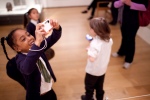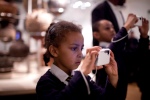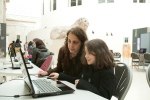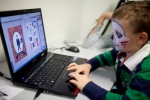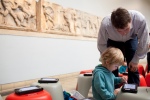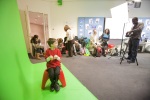Project examples emailed in response to a request via GEM, DLNET and MCG lists Sep 2010.
Sent: 06 September 2010 08:07
To: GEM@JISCMAIL.AC.UK (and MCG, DLNET)
Subject: Engaging young people with social mediaI am doing a session at the GEM (Group for Education in Museums) conference this Thursday on ‘Digital technology and young people’ and thought I should get an update on current and recent projects. If you know of one, or are involved in a project involving digital technology that focuses at least partly on young people I would love to hear about it.
I will post a summary of responses.
Martin
I work with the Irish Heritage Trust at Fota house in County Cork and we have just launched Phase I of the www.fotalearningzone.ie It’s an on-line teacher’s resource for Transition Year – a non-exam focussed developmental year- and Leaving Certificate students ( equivalent to Year 11 and A level respectively). The resource offers teachers material for pre and post visit work and will be complimented with on site workshops.
Our objectives are to create paths to access into heritage for young people through a medium that they – as digital natives – will be conversant with. The resulting website was based on front end evaluation project carried out with Irish teachers earlier this year and we are about to embark on some formative evaluation.
The interpretive framework of the resource hangs on a number of themes that we hope will make Fota relevant to young people by looking at what the house meant when it was built and what it means today.
We have included a range of software and have used WebQuests – for students to undertake to encourage research skills and hopefully lively debate! This material relates to themes that we hope will help contextualise Fota house, its stories and those who lived there, and situate it in Irish culture both past, present and future. Big houses here have been regarded as contested heritage and therefore very much link to the history curriculum, an opportunity that we have exploited in for example our ‘Land Acts’ unit. There are also a number of other strong links to various other subjects such as Marketing in our ‘Plan an Event’, themed unit.
I would be very happy to discuss this further with you if it is of interest. I would also be very interested to hear of other projects focussing on young people so look forward to seeing the summary of your responses.
Kind regards
Jennifer
This summer we ran a young people’s project at Brading Roman Villa, called VILLA 2010 (Volunteers Investigating Local Living Archaeology). This involved a group of 15 young people coming on site and getting involved with activities related to our summer excavations as well as looking behind the scenes of how an archaeological museum runs. We started a Facebook group for this, here: http://www.facebook.com/home.php?#!/group.php?gid=145395475474959&ref=ts
and generally we have a profile on facebook for Brading Roman Villa: http://www.facebook.com/home.php?#!/profile.php?id=1359201815
Hope this is useful!
Hannah Lowish
BRV volunteer
Hannah Lowish [hlowish@hotmail.com]
We are about to embark upon a project with P5-6 (age 9-10) classes from Musselburgh in East Lothian. Each class will work with ‘buddies’ aged 65+ to discover each other’s childhood role models. The classes will document and share the project using ‘Edubuzz’ (http://edubuzz.org/blogs/) – East Lothian’s blogging site for schools. The classes will then commission a digital artist to work with them to create online digital art pieces related to these role models. The artwork will interpret the timeless characteristics and ambitions common to young people through the decades. The project is designed as an intergenerational learning experience where pupils and ‘buddies’ learn together about blogging and use of technology such as video cameras, digital cameras, photo editing software, etc.
Let me know if you have any questions!
Thanks,
Sarah
Sarah Cowie
Museums Education Officer
East Lothian Museums Service
Museum Headquarters
Dunbar Road
Haddington EH41 3PJ
Telephone: 01620 828225
Fax: 01620 828201
www.eastlothianmuseums.org
Find us on Facebook – ‘East Lothian Council Museum Service’
Hi Martin
Here with HYPE recently had a photographic project resulting in exhibition and next project will involve some filming and hopefully website creation.
Kay
__________________________________________
- Kay Topping
- Education Officer
- Haslemere Educational Museum, 78, High Street, Haslemere, Surrey, GU27 2LA
- Tel: 01428 642112 Fax: 01428 645234
- Charity No.1071244, Company No. 3203702
- Curator Julia Tanner
Education@haslemeremuseum.co.uk
Hi Martin
Our latest project may be relevant.
www.npg.org.uk/creativemediadiploma
Helen
—————————————————————————-
Helen Whiteoak
Head Of Participation
National Portrait Gallery St Martin’s Place London WC2H OHE
020 7321 6278
Apologies that we are unable to respond at length on this subject – we are very short of time at the moment.
However, we thought that we should at least send you the link to a couple of case studies, which will be of interest:
- Crawford John storypods and 2. the Hunterian Museum and Art Gallery iPhone app:
http://www.museumsgalleriesscotland.org.uk/what-we-do/digital/
- Borders Council ‘Warp, weft and edit’: exploring our textile heritage through the lens:
I hope this helps
Helena Gillis
Learning and Access Manager
Museums Galleries Scotland
Helena Gillis, Learning and Access Manager
T: 0131 550 4132
Museums Galleries Scotland, 1 Papermill Wynd, McDonald Road, Edinburgh, EH7 4QL
T: 0131 550 4100. F: 0131 550 4139.
E: inform@museumsgalleriesscotland.org.uk W: http://www.museumsgalleriesscotland.org.uk B: http://mgsblogs.wordpress.com
Harvest Heritage Arts and Media have been involved in several projects of this kind.
Our most recent is an audio drama based interpretation and learning resource, ‘Peopling The Georgian House’. Inspired by the “speaking tubes” in the house, young people imagine and record what they would have heard if they had “bent an ear” to conversations taking place in the 1750’s. This is being launched this term. We hope to be able to podcast the results in due course using YouTube, Vimeo and Facebook.
Other audio/visual projects include delivering the media training and support with young people who have made documentaries for Their Past Your Future projects with The Royal Naval Museum and Bristol City Museums Galleries and Archives.
For the RNM TPYF project, ‘Face to Face’, we worked as sole contractors, with RNM and a primary school, in which Yr 5 pupils interviewed those with personal experience of conflict (WW2, Falklands, Gulf, Iraq) We produced a DVD of interviews and a “making of”. At the end of the project we staged an awards ceremony, with red carpet, popcorn, oscar statuettes etc. The films were screened on The City Screen in Portsmouth, posted on the museum website, and will form part of an educational resource called ‘Remembrance Kit Bags’.
For Bristol’s TPYF project we worked as one of a number of contracted partners. Our role was to train young people at secondary school (Yr 9) in interview techniques and support the shoot day. The interviewees included refugees and asylum seekers from Poland, the Arab/Israel conflict and elsewhere.
Digital Stories – I have also made numerous digital stories, some of which are streamed on the Bristol Stories and Electric December websites. Electric December is an online advent calendar of digital gifts http://www.electricdecember.org. For examples of the work with young people see http://www.electricdecember.org/06/calendar/10/
Last year I facilitated the making of digital stories by young people for a festival about Paul Robeson. The films were screened in an exhibition in the foyer of The Bristol Old Vic, screened in the foyer of Watershed Media Centre and also hosted online on the Bristol Stories site. Www.bristolstories.org (search under Robeson)
Previous to this I devised audio drama strategies for intercultural interpretation at The British Empire and Commonwealth Museum and Understanding Slavery Initiative. These were broadcast on a community radio station, but such an approach could now use social media and online streaming for dissemination.
Best wishes
Anna Farthing
Website www.harvestfilms.co.uk
The Samsung Digital Discovery Centre at the British Museum which opened in March 2009 has a core digital learning programme which exclusively targets young audiences. We work with children age 5-19 in the context of school and family visits to the museum. The highlights of our current programme and recent projects include:
- 7 school sessions for foundation and primary. The most interesting of these for your presentation are likely:
- Multimedia Magic. An ICT-based session in which children follow a Prezi trail in the Ancient India gallery using handheld computers and capture photos, voice recordings and videos. Following the gallery visit they work in pairs on laptops to create interactive posters with Glogster – a web 2.0 tool. This session was an experiment to see if teachers would bring students to the Museum to do ICT without knowing what subject area they were going to cover. It has been very successful. Here are a few examples:
- Painting for the Afterlife. In this session children use the web 2.0 tool Vuvox to create photo collages of their ideal afterlife. (We first introduce the Nebamun tomb paintings and talk about how the ancient Egyptians created representations of their ideal afterlife.) We use a Flickr account like a database to store images centrally which can be accessed through Vuvox. An example:
- Sutton Hoo Headline. We do a video session where children create video news reports about the objects found at the Anglo Saxon burial ground at Sutton Hoo. They are filmed in front of the green screen and children choose what backgrounds they want to use. They plan, script and film the report themselves. An example:
- We offer more digital family programmes on the weekends. There are over 20 different activities. Many of these involve using Photoshop to create image collages and digital photography. The best place to see example work from these sessions is our Flickr site:
- http://www.flickr.com/britishmuseum_samsungcentre
- Sutton Hoo video activity with families: http://www.vimeo.com/14115652
- One of the most interesting (and challenging programmes we did this year was using Blender for 3D animation, the results of which can be seen at: http://www.vimeo.com/14296595
- We also do project work outside of the core programme. A few highlights from the past year have been:
- Talking Objects: a participatory approach to interpreting a single object in the museum’s collection. This involves teenagers from local community groups working with a media artist to reinterpret the object and feed back to curators. In July, a group from Coram created a film/mixed media production: http://www.vimeo.com/13729165
- Robots in the gallery. We collaborated with a school in Worcestershire on a distance learning project where children operated a robot remotely through a gallery. They could see a live video feed from the robot’s camera as it moved through the gallery.
- Collaboration with the Cartoon Museum in which teenagers retell a myth or legend in digital animation. An example of Beowulf: http://www.vimeo.com/12771142
- We offer more digital family programmes on the weekends. There are over 20 different activities. Many of these involve using Photoshop to create image collages and digital photography. The best place to see example work from these sessions is our Flickr site:
This gives a reasonably good sense of the range of what we are doing. I have attached a few images to give an idea what the space looks like.
Feel free to use these in your presentation. You can use download some example artwork or photos from our Flickr site. If you could just include a credit line on the photos (Photo compliments of The British Museum) that would be great.
Feel free to pass on my contact details to folks on Thursday if they want more information on the Centre or its programmes.
Warm wishes,
Shelley Mannion SMannion@britishmuseum.org
COMING SOON – BOOK NOW
Journey through the afterlife: Ancient Egyptian Book of the Dead
Opens 4 November 2010
Under 16s and Members free
TICKETS +44 (0)20 7323 8181
www.britishmuseum.org
BECOME A MEMBER +44 (0)20 7323 8195
www.britishmuseum.org/membership
Connect with the British Museum online
www.facebook.com/britishmuseum
www.twitter.com/britishmuseum
Since last July The History of Advertising Trust has been creating online resources with the help of an independent web consultant (Gareth Davies from Advisory Matters) and funding from a Heritage Lottery grant. I’ve attached more details for you and a copy of our launch and open day invitation, planned for the 12th of November. Our funding lasts until June 2011 and we aim to have a CPD moodle with 3 modules on it, relevant to teachers of media (KS4 and KS5). The online resource is still under development but one module is near completion and will be test-run by our Teacher Forum group and their schools over the next 3 months. Our plan is to launch a marketing campaign at the end of this year that will promote the service to schools and local education authorities with the hope that it will be hosted on elearning platforms in our East of England region first, but ultimately nationally. Last week a local independent media production company filmed at the offices of advertising industry giants BBH to give teachers and students insight into the world of work. We also asked them questions directly relevant to the CMD unit ‘Campaign’.
Let me know if you need any further information. I attended your DLNet event in London about creating online resources and found it extremely useful when tackling our project. Thank you!
Regards
Jane Easey
Learning and Access Development Co-ordinator
The History of Advertising Trust
HAT House, 12 Raveningham Centre, Raveningham,
Norwich, Norfolk, NR14 6NU Phone: 01508 548623 Fax: 01508 548478
www.hatads.org.uk
The V&A runs the Create! programme, targeting 11-19yrs. One of the key element of this ongoing programme is digital art and design. Events include digital photography, experimental digital film, creative computer coding, interactive design, product design etc where young people work with top digital designers in the Digital Studio in the Sackler Centre for Arts Education at the V&A.
In spring there a digital festival for young people, offering taster workshops, plus free talks and demonstrations. Next year’s will be Saturday 5th March
To get a flavour of the workshops that take place, visit www.vam.ac.uk/create under Create!live, and by viewing the YouTube link and Flickr links you can see examples of past digital workshops.
We have also been working with youth groups to recruit young people to a project called Digital Pioneers which we launched when the Sackler Centre opened. The aim of the programme is to help young people to develop their digital skills and own creative project ideas with digital mentors and to give them an industry insight. Young people are recruited through youth inclusion groups and have taken part in animation, architecture and interaction design projects with artists and designers in residence at the V&A. The young people develop their portfolios and some have gone on to FE & HE courses as a result.
let me know if you need any more info
Best wishes
David
David Judd
Creative Projects Manager
Learning and Interpretation Division
Victoria and Albert Museum
Cromwell Road
South Kensington
London SW7 2RL
020-7942-2441
At Museum of London we have just piloted and are preparing to run a session for secondary school students, called “Impact of Empire”. The study day blends “traditional” museum education such as drama and object handling with a gallery session using technology. Students begin by solving riddles which lead them to various displays in the galleries. QR Codes are placed around the gallery cases, which when scanned with an iPhone, link to blog pages where students can discuss and investigate artefacts and concepts which relate to the effect of empires on London’s past and present. After the activity, the blogs become teaching and discussion resources back at school for lessons.
The project has been evaluated and researched as a way of creating “user generated contexts” rather than ”user generated content” as students have the option of setting riddles for each other and dictating the direction of the study. A full research paper will be released in the near future, but we did find that students were highly engaged, comfortable with using the technology and able to take control of and self direct their own learning through it.
Best regards,
Alex Flowers
Alex Flowers
e-Learning Assistant, Learning Departments
Museum of London
150 London Wall
London. EC2Y 5HN
Tel: 020 7814 5774
Fax: 0870 444 3853
Email: aflowers@museumoflondon.org.uk
www.museumoflondon.org.uk
Discover the story of the world’s greatest city and its people at the new £20 million Galleries of Modern London, now open at Museum of London.
Follow us online:
www.museumoflondon.org.uk
http://twitter.com/MuseumofLondon
www.facebook.com
www.scribd.com
www.mymuseumoflondon.org.uk/blogs
I’m not quite sure if this is what you mean, but I am 2 years in to a 5/6 year digital sound & animation project.
Each year, the project begins with a training day for the teachers involved in the project, then each Key Stage 2 class has 2 days of training and inspiration – a half day site visit, then half the class is trained in making, recording and editing sound, while the other half of the class is trained in stop frame animation. All training is done in small groups, and the children train the remaining children in either sound or animation after we leave, which means they practice what they have learnt immediately to fix it in their minds. the class then works on creating a short animation over a school term, and we hold a ‘film premiere’ for all the films in a theatre or cinema at the end of the term. We then get the films uploaded onto a website.
In year 1, 5 schools on Anglesey created their own short animations interpreting prehistoric burial chambers in an abstract way. Those films are available to view here:
http://www.songsfromstones.co.uk/map/
We are just finishing the second year, and have 6 animations focussing on 4 medieval castles in north east Wales, which will be uploaded to the suite soon.
Year 3 is taking place in south east Wales, looking at Roman sites.
Year 4 is taking place in south west Wales, looking at medieval religious sites.
Year 5 is taking place in north west wales, looking at castles of the Princes of Gwynedd
we may do a final year looking at historic sites in mid Wales.
The feedback from schools involved in the project has been very positive, and they have all said that it is a fantastic way of delivering a skills based curriculum.
best wishes
Adrienne Goodenough
Rheolwr Dysgu Gydol Oes/Lifelong Learning Manager
Cadw, Llywodraeth Cynulliad Cymru/Cadw, Welsh Assembly Government
Swyddfa/Office 01443 336142 Symudol/Mobile 07792 612389
Ffacs/Fax 01443 336001
Plas Carew, Uned 5/7 Cefn Coed, Parc Nantgarw, Caerdydd CF15 7QQ
Plas Carew, Unit 5/7 Cefn Coed, Parc Nantgarw, Cardiff, CF15 7QQ
Ebost: adrienne.goodenough@cymru.gsi.gov.uk
Email: adrienne.goodenough@wales.gsi.gov.uk
The new Antenna site (http://antenna.sciencemuseum.org.uk/) is designed to help engage teenagers with contemporary science issues, and uses elements of social media alongside content designed to be accessible and relevant.
Mia Ridge
Sent: 06 September 2010 08:07
To: GEM@JISCMAIL.AC.UK
Subject: Engaging young people with social media
I am doing a session at the GEM (Group for Education in Museums) conference this Thursday on ‘Digital technology and young people’ and thought I should get an update on current and recent projects. If you know of one, or are involved in a project involving digital technology that focuses at least partly on young people I would love to hear about it.
I will post a summary of responses.
Martin

